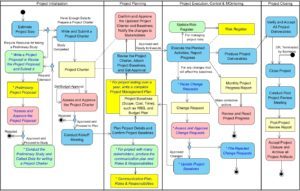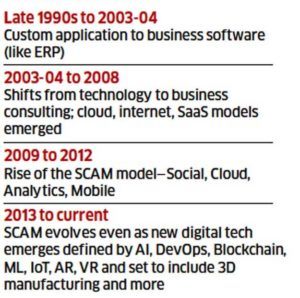Infosys: Can “Coders” become “Creators” in the new digital world

How Infosys is trying to keep its 300,000 employees from becoming irrelevant in the Digital Era?
The IT services industry is the biggest private-sector employer in India (employing 3.9 million people) which earned an aggregate revenue of $160B in 2016. Infosys Limited was founded in Bangalore, India in 1981 to cater to the needs of organizations across the world to develop, operate and maintain large-scale, customized IT system. As IT systems became the backbone of organizations across the globe, Infosys leapfrogged to become a large multinational organization with a market capitalization of $33B and a revenue of $10B by 2017. [1] [2]
Given the replicable nature of work involved in IT projects, Infosys was able to develop a scalable “supply-chain” of IT project delivery. The IT “supply-chain” consisted of 4 parts:
- Initiation
- Planning
- Execution, Control & Monitoring
- Closing [4]
These steps could further be divided into sub-steps as shown in the below schematic:

The Digitalization Challenge
Like most other industries, the IT industry has been getting disrupted by digitalization too. Thanks to a massive shift in underlying technology, the deployment and maintenance of large-scale IT projects now require fewer and fewer IT engineers. Infosys Limited laid off 11,000 software engineers in 2016 and has estimated that 100,000+ traditional coders might lose their job in next 5 years if it fails to reskill its 300,000-strong workforce to new age digital technologies. [3]
The following infographic shows the major shifts in the IT industry over the last 2 decades:

- Phase 1: Custom Applications –IT engineers had to write codes from scratch and deploy, test, operate and maintain IT application on client servers. Any change in existing IT applications required long cycles of planning and deployment and typically required several iterations.
- Phase 2: Business Software – Software companies across the world started bundling common IT applications to be sold as prepackaged software (ERP, CRM etc.) which enabled companies to deploy common business software quickly
- Phase 3: SaaS, PaaS, IaaS – Improvement in internet speeds enabled usage of Software, Platforms, and Infrastructure “on the cloud”. Standardized development platforms reduced the need for custom development. Using SaaS, PaaS or IaaS, clients could easily scale up or down in real time based on the organizational demand. These technologies rapidly deskilled the process of building IT application.
- Phase 4: New Age digital technologies – The rapid explosion of digital technologies such as Analytics, AI, DevOps, Blockchain etc. along with better tools to create business software has resulted in lower demand for traditional IT projects and increasing demand for complex digital projects
Adapt or Perish?
The key question in this context ahead of companies like Infosys, which has 300,000 people trained on old age technologies such as SDMS is how can they rapidly retool their workforce in the age where technology is changing at a rapid pace.
With changes in underlying technologies, Infosys also needs to change the fundamental thinking process behind software development. The workforce at Infosys is largely trained at codifying set business processes. With a host of smart tools available today, a large portion of coding & testing has either been automated or deskilled. With benefits from traditional IT systems plateauing out, organizations are demanding new-age IT systems based on advanced analytics, AI, and Machine learning. A study by NASSCOM predicts that the Indian IT industry will need to shift 40% of its 4 million employees from manual, repetitive coding work to smarter, creative application building over the next five years to stay relevant in the face of digitalization.
Efforts so far
Infosys has started creating design thinking platform to both re-skill people and drive innovation. It has also started working with massive open online course (MOOC) providers to skill fresh hires and reskill existing employees. Apart from courses in digital technologies, Infosys also invests in changing people’s personalities & learning abilities and also monitors post-learning retention & applied by the employee. [5]
Despite large-scale efforts by IT firms as well as industry federations, as much as 56,000 employees were laid off across top 7 IT firms in India in 2017. [6]
A Larger problem
The problem with Infosys is much larger than a simple skills gap issue. It has to do with the broader education system in developing countries like India. Indian engineering schools have outdated curricula which glorify and promote an exams-and-marks-oriented approach to teaching. The curricula followed in Indian universities emphasizes on content and the neglect of higher-order thinking skills. This does not help students become creative and critical thinkers. For digital age companies such as Infosys to keep innovating sustainably and stay ahead of the curve, they have to work with the Indian engineering schools to overhaul the higher education system. [7]
Questions and Reflection
- As improvements in technology are eliminating lower order jobs, can developing world companies like Infosys adapt to become leaders in innovative & creative jobs as successfully as they did in repetitive, predictable jobs?
- How can education system train youth on a large scale to be design thinkers & creators in a world where digitalization is taking over repetitive jobs quickly?
Citations
[1] “How the Indian IT services sector is seeking to make its biggest transformation”. Shelley Singh. https://economictimes.indiatimes.com/tech/ites/how-the-indian-it-services-sector-is-seeking-to-make-its-biggest-transformation/articleshow/60502487.cms
[2] http://www.moneycontrol.com/financials/infosys/profit-lossVI/IT#IT
[3] “Infosys releases 11,000 employees due to automation: Key takeaways from board meet” 2017. https://economictimes.indiatimes.com/markets/stocks/news/infy-lost-11000-jobs-due-to-automation-key-takeaways-from-board-meet/articleshow/59298660.cms
[4] http://www.cityu.edu.hk/pmo/projectlifecycle.htm
[5] “IT reboot: How Infosys, TCS, Wipro & HCL are re-skilling employees to beat automation”. 2017. http://www.moneycontrol.com/news/trends/it/it-reboot-how-infosys-tcs-wipro-hcl-are-re-skilling-employees-to-beat-automation-2323469.html
[6] “Top 7 IT firms including Infosys, Wipro to lay off at least 56,000 employees this year”. Varun Sood. http://www.livemint.com/Industry/4CXsLIIZXf8uVQLs6uFQvK/Top-7-IT-firms-including-Infosys-Wipro-to-lay-off-at-least.html
[7] “What ails higher education?” 2014. http://www.thehindu.com/features/education/research/what-ails-higher-education/article6491934.ece



The question of whether companies can pivot from repetitive jobs to creative ones is very interesting. We are seeing this change not just in India, but also in China; where more and more of their economy is diversifying from manufacturing to services. I believe companies like Infosys do have this capacity to pivot largely because they have a very skilled (and young) employee base. I am not sure that overhauling the education system is necessary as I am not sure that creativity can be “taught” in schools. Creativity comes about by posing big challenges to employees that conventional methods will not solve. In the case of Infosys, I would also argue that also external factors also a played a role in the layoffs – namely changes in US immigration policy. When less Indian engineers were able to enter the US to fulfill client contracts; the company naturally has to lay them off.
Interesting post! Although it is a problem in the IT industry, it is essentially a people’s problem. The companies in Silicon Valley say that they are short of engineers, but as much as 56,000 employees were laid off in 2017. I suppose not all of them are engineers, of course, but clearly the human capital is not fully utilized in a global scale. Infosys has been the solution for engineering scarcity, but if the company failed to train its employees, it could become the bottleneck of new technologies. I guess the world needs to find the human resource else where. Would that be in another emerging county, would AI be able to take some repetitive jobs, or would Infosys be able to reinvent itself?
Fascinating topic – thanks for posting, Mitesh! 56,000 is a staggering number of people being laid off in India, I had no idea that the issue is this drastic. A career in software engineering is a commitment to being a life-long learner and I have seen how more seasoned employees struggle with the ever-changing technology landscape. It would be interesting to learn the age profile of the employees who lost their jobs. As you mentioned above, one way to mitigate the issue is education. Here I would emphasize that academic programs must focus on the fundamentals of computing rather than on specific technologies that might be retired in the near future. The other opportunity is to find management and leadership roles for individuals who no longer want (or have the capacity to) adapt to new technologies. To create such opportunities, the organization would have to find an operating model where seasoned engineers can add value in project management and organizing development teams. It would be interesting to learn more about how these companies are organized operationally to deliver software at this scale and quantity.
Digitalization is transforming everything, even companies that create technology! What to do with a resource that no longer can help you create value for your customer? Do you discharge it or invest in its maintenance? Your article does a very good job of demonstrating that these questions can be applied in the Infosys context challenge.
I am a computer engineer myself and what I learn in college is already outdated. Some important technologies did not even exist during the time of my studies and I can see the challenge of keeping updated in this rapidly changing environment. The idea of investing in the maintenance of your resources through education is key to this problem and the best for the company and the employees.
This challenge is not only for Infosys but for global technology companies and there is a new education industry emerging to help to solve this: Bootcamp graduation programs [1]. My position is that, instead of partnering with universities, the company should try to take advantage of this new education system to update the knowledge of its workers.
[1] https://techcrunch.com/2017/03/22/at-50-dev-bootcamps-michael-jay-walker-quit-his-day-job-to-learn-coding-with-kids-in-their-twenties/